If you’re a sock knitter you’ve undoubtedly heard of it before: SSS or Second Sock Syndrome. Another affliction plaguing many knitters. But what can you do if you have it? Which strategies can you attempt to cope with it and which ones have the best chances of working for you?
What is the Second Sock Syndrome?
SSS usually refers to the inability to produce complete pairs of socks. Knitting the first sock usually goes quickly. But the second one seems to drag on, never gets completed or even cast on in the first place.
This is due to a lack of motivation and interest. Knitting the second sock often amounts to knitting the same thing twice in a row. We already know what’s coming, what it’s like to knit this sock. The thrill of the new is gone, and it doesn’t hold our interest as much as the first one did.
But you may find that you don’t suffer from it all the time or at least not to the same extent. Sometimes knitting a complete set is easy and sometimes you struggle. Your motivation might change, or it might be your mood or what you are doing to accompany your knitting (audiobook, podcast, movie night or just good company). Try to notice these changes and the reasons for them. It might help you in the future!
Second Sock Syndrome may also show its face in a different form: You may also have trouble finishing the second sleeve of a sweater or in very severe cases even a complete pair of gloves. Gloves are usually less of a problem because they are (typically) faster knits than socks or sleeves. Anything that consists of knitting the same piece over and over can be problematic.
If you’ve come to visit my little corner of the internet before you probably know how I feel about knitting the same thing twice. I get bored easily. But I never really had a problem with finishing pairs before. I can still count the number of single socks I’ve knit in my ten plus years of knitting on the fingers of one hand. And most of these had some issue with the fit. I do feel the itch while knitting the second sock, but I still complete it.
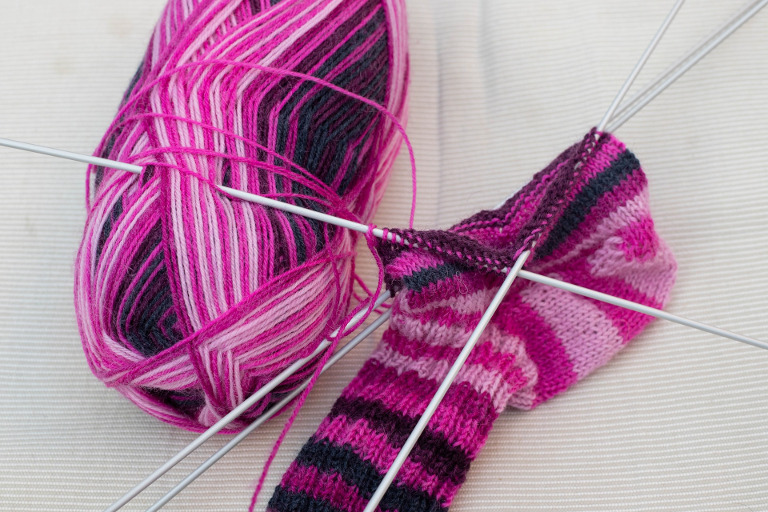
How to Fight Second Sock Syndrome
There are three things I usually do that make it possible for me to complete pairs even though I get the urge to do something else instead. And a couple of more that work for me or that I have heard of and that I think might work as well.
1 – I Really, Really Want Those Socks
I love the design, and love the yarn I’m using. I want to be able to wear them and can picture myself doing so. If I knit for someone else, I imagine giving them away and seeing them being worn. That is less effective than really wanting them for me since the recipient is usually less interested in the design and more interested in having warm and comfortable feet but can still work.
2 – I Cast on the Second One as Soon as I Finished the First One
And I really mean “as soon as.” I allow for no more than five minutes to pass in between if it’s at all possible. That way I have a project on the needles I can grab and knit whenever I have a few minutes. If I knit cuff down I will also knit at least one row of the ruff before putting the needles away, so the hard part is done. Casting on can be quite fiddly and usually takes a bit more concentration because I need to count. So I get it out of the way.
3 – I Don’t Allow Myself to Cast on Anything New Until I’ve Finished the Pair
I follow this rule less strictly. But I do make sure that I only ever have one active sock project. And I don’t allow myself to let sock projects to become to dormant. Unless I’ve put them into knitting time-out because I kept making stupid mistakes. (That’s why it took me almost two years to finish my Lissajous knee socks.)
4 – Don’t Put It Away
If you leave your sock project out in the open, it’s much more likely that you’ll pick it up and knit a few rows. The sight of it may nag you, or it’s just close to you when you have a few minutes. If you put it away, chances are it’s going to become a UFO instead.
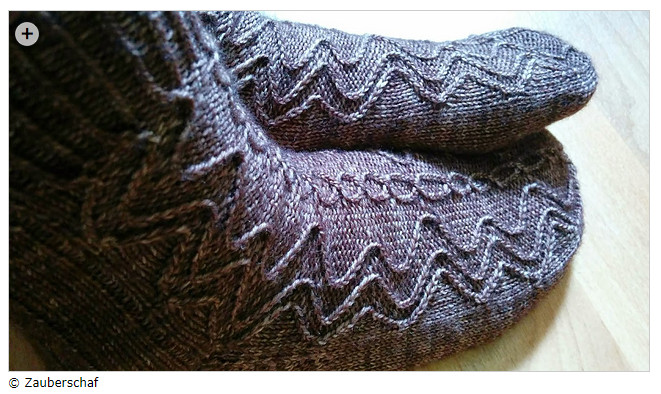
Complex enough to keep you going? Drachenaugen by Scarlet Plume
5 – Choose an Interesting and Complex Pattern
If you choose a pattern that is interesting with a few different things going on or that may even be a little difficult for you, you may not have any problems with SSS at all. I’ve noticed that if the pattern is just intricate enough to be a bit of an adventure and it has a couple of different things going on that I can watch develop and grow, it works well. By the end of the first sock, I’ve just about gotten a feel for the pattern and the second one is easier to knit – but not boring.
I can’t choose a pattern like that every time. Sometimes I’m knitting socks for someone else. Or I’m deliberately looking for something easier to knit. It’s also not always easy to find such patterns in the first place. You have to know yourself and your knitting ability really well. And lastly, these patterns don’t usually work well with variegated hand-dyed yarns.
6 – Choose a Design Where the Second Sock Mirrors the First
This is a nice little way I can trick myself with. If the second sock mirrors the first, it almost feels like a different sock. I need to pay attention, so I don’t knit the same sock twice, and I still have to refer to the pattern and charts at times.
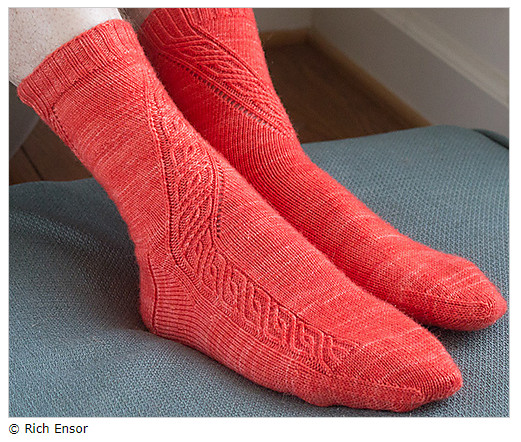
A pretty example for a mirrored design: Angular Velocity by Rich Ensor
7 – Knit Two Socks at the Same Time
I’ve done this as well. More to try it out and learn something new than to combat Second Sock Syndrome with but it works. There are different ways to do this, too. You can cast them on next to each other on the same circular needle. Or you could knit them on two circulars or toe-up. There is plenty to find on Youtube, and I found the book 2-at-a-Time Socks (*) by Melissa Morgan Oakes very helpful to get the basics down.
Or knit the two socks inside of each other. Now, this method I haven’t tried yet but I’ve seen it before and it seems to be similar to double knitting. And it’s on my list of things to try out in the future because it seems like fun.
Both methods require you to divvy up your yarn equally (unless you are using half-sized skeins), so you will need a kitchen scale. And both take a bit of effort and focus to learn. I wouldn’t advise a novice sock knitter to attempt either. You should at least have the basics down and be familiar with sock knitting first.
8 – Find an Accountability Buddy
You can find those in many places. It could be a Ravelry group, Twitter, Instagram or a real-life knitting group or friend. There are tons of places you could find one. Where ever you find them tell that person (or the group) of your problem and ask them to help keep you on track. You show them your continued effort to knitting the second sock, and they keep hounding you if you forget. This works well for other things (studying, work, health-related stuff, etc.) and it’s one of those “productivity tricks” you often read about on the internet. If someone
is watching your progress, you are more likely to follow through because you don’t want to disappoint them or look bad.
If the other person also suffers from SSS, make sure you get a third person to look over you or start an entire support group. You need someone who is not as likely to be afflicted with it to be able to call you out on your lack of progress. If they themselves have a sock they haven’t worked on in a while, they might not remind you so that you won’t remember that second sock they still have hibernating.
9 – Reward Yourself for Finishing a Pair
It works for other things, so why not for SSS? Find something you really want to do or get and reward yourself with it when – and only when – you’ve finished the second sock.
The next three tips are all from one post I’ve read on a blog called Strung Out and are things I hadn’t considered or heard of yet. I thought them to be interesting and possibly helpful so I wanted to include them here.
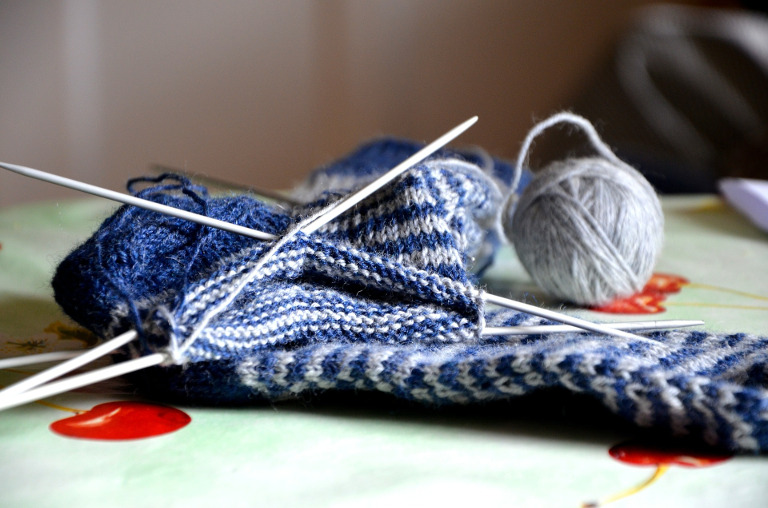
10 – Knit a Series of Singles Before Going Back to Knit the Second Socks
Knit a few different first socks of a pair – two or three or however many works best for you – and then go back to knit the second socks of those pairs. A very straightforward solution, if you think about it. But there are a few possible problems.
Some knitters might still have a hard time knitting the second sock after a knitting a few others. Maybe if more time passes but then you are left with a lot of unfinished projects in the meantime.
Also, your gauge might change if you come back to it after a long while. Or you may not remember everything you thought you would about knitting the first and your notes are incomplete – or you’ve lost them. It’s easy to end up with socks that don’t quite match this way.
If you attempt this, try only two to four pairs at first – it depends on how fast a knitter you are I would say. And take detailed, precise notes, even of things you think you always do this way or you certainly won’t forget. And store them with the project, or better yet on Ravelry. Better safe than sorry.
11 – Knit the Second Sock Upside down and Backwards
This is an interesting solution. It would make the second sock different enough to feel like a new project. But you will have to find a pattern that will look the same no matter if you knit it toe up or cuff down. That does require some experience. And you need to be able to wrap your head around it, figure out how to do it. That’s not rocket science, but it does require concentration and good spatial awareness.
12 – Switching the Knitting Style
If you are usually a thrower or English knitter you could knit the second sock continental. Or try Portuguese knitting or lever knitting for that matter. This adds a new element and might be enough to keep you at it. And you get more experience with a different knitting style as well!
There are a few problems with this, however. First of all, you are likely not as proficient in this knitting style which means you will be slower and the second sock will take longer to finish. That might aggravate the Second Sock Syndrome even further. Also, changing the way you knit (or even the type of needle you are using) can affect your gauge. The second sock might come out a different size than the first.
If All Else Fails
Try and live with it. Enough people wear fraternal pairs of socks as a fashion statement. Kids do it for fun! You can, too! Just try and make enough socks similar sizes and styles, so the fit is the same.
Do you suffer from Second Sock Syndrome? Every time you knit socks or just now and then? What do you do to overcome it? Please let me know in the comments below!
Affiliate disclaimer: This post contains affiliate links (links marked by (*)). That means that at no extra cost to you I will receive a small compensation should you choose to purchase after clicking on such a link. Please, read this for more details.
Did you enjoy this post? Then please share it on Pinterest!





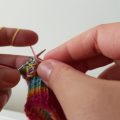

My method is to have two sets of needles and cast on the ribbing for both needle sets. I stitch on one down to the heal, put it aside, stitch the other one to the heel. Turn the heel for both, then take turns knitting on one than the other. Soon both are finished!
This is also a great idea! If you are working those sections back to back, you still have more “new” things ahead of you. And the memory of how you knit a part the first time is still fresh in your mind. That makes it easier to copy it the second time around.
Thank you for sharing, Jo! I always love to hear about how other knitters deal with common pitfalls and problems! I always learn something new.